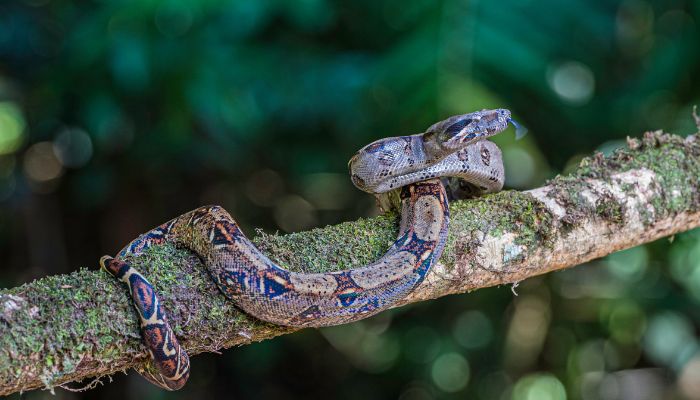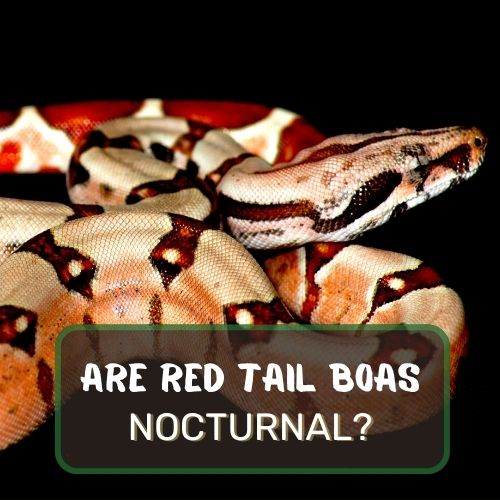So you’re the proud owner of a red tail boa, and you’re wondering how to create the perfect environment for your slithery friend. One word: Humidity. It’s not just about making your hair frizz; it’s a crucial factor for your boa’s well-being.
Absolutely, red tail boas do need humidity for their well-being. The optimal humidity range for these snakes is between 55-75%. Proper humidity is crucial for various physiological processes, including successful shedding of their skin.
In this comprehensive guide, we’ll delve into the optimal humidity range, how to measure it accurately, and effective methods to maintain it. We’ll also tackle common mistakes to avoid and answer some frequently asked questions.
Trust me, by the end of this article, you’ll be a bona fide humidity guru for your red tail boa.

Table of Contents
The Optimal Humidity Range for Red Tail Boas
Humidity is not just about making your hair frizz; it’s a life-or-death matter for your slithery friend.
What’s the Ideal Range?
Let’s cut to the chase. The optimal humidity range for a red tail boa is between 55-75%. This isn’t a number pulled out of thin air; it’s based on their natural habitat and biological needs.
Imagine you’re in a tropical rainforest. It’s not just wet; it’s a balanced ecosystem. Your red tail boa’s enclosure should mimic this as closely as possible.
Why Does It Matter?
Now, you might be wondering, “Why such a specific range?” Well, humidity plays a crucial role in various physiological processes for your boa, like shedding. When it’s time for them to shed, the humidity needs to be on the higher end, around 75-85%.
This helps the old skin to come off in one piece, making your snake look like it just had a spa day.
The Risks of Getting It Wrong
Too low or too high, and you’re asking for trouble. Low humidity can lead to incomplete shedding, and trust me, no one wants to see a snake in a half-shed state; it’s like watching someone walk around with peeling sunburn.
On the flip side, consistently high humidity can lead to respiratory issues and even fungal infections. It’s not just about comfort; it’s about health.
The Seasonal Twist
Oh, and let’s not forget, seasons change! Your indoor humidity will fluctuate with the weather outside. So, you can’t just set it and forget it; this is an ongoing relationship.
You’ll need to be as attentive to your boa’s humidity needs as you are to your plants, or your skin, or heck, even your curly hair on a summer day.
How to Measure Humidity Accurately
Alright, so we’ve established that humidity is a big deal for your red tail boa. But how do you go about measuring it? You can’t just stick your hand in the enclosure and say, “Hmm, feels humid enough.” Nope, you need the right tools for the job.
Ditch the Analog, Go Digital
First things first, let’s talk about those cheap stick-on analog humidity gauges you might have seen at the pet store. You know, the ones that look like they belong in a 1980s weather station?
Yeah, those are about as reliable as a weather forecast that calls for “a chance of rain or sunshine.” They often show incorrect numbers, and an inaccurate reading can lead to all sorts of problems, from shedding issues to respiratory infections.
Instead, what you want is a digital hygrometer. These gadgets are the gold standard for measuring humidity in reptile enclosures. They’re more expensive, sure, but consider it an investment in your pet’s health. I mean, you wouldn’t skimp on your child’s thermometer, would you?
Brands Matter
When it comes to digital hygrometers, not all are created equal. Brands like Zoo Med and Exo Terra are generally trusted in the reptile community. They’re easy to read, reliable, and durable—everything you want in a device that’s going to help you keep your pet healthy.
Calibration Is Key
Once you’ve got your digital hygrometer, don’t just slap it in the enclosure and call it a day. These devices often need to be calibrated to ensure they’re giving you an accurate reading. It’s like tuning a guitar; it needs to be just right to hit the perfect note—or in this case, the perfect humidity level.
4 Methods to Maintain Humidity
Alright, you’ve got the numbers, you’ve got the tools, but how do you actually maintain that sweet spot of humidity for your red tail boa? Don’t sweat it; I’ve got you covered. Here are four tried-and-true methods to keep that enclosure as balanced as a Zen garden.
Using a Water Bowl
Let’s start simple. A water bowl is not just for sipping; it’s also a natural humidifier. But don’t just grab any old dish. The bowl should be large enough for your snake to curl up in and heavy enough not to tip over.
Place it under the heat source to help the water evaporate and increase humidity. Just keep an eye out for any “bathroom activities” in the bowl. Snakes sometimes like to multitask while they soak.
Mixing Water into the Substrate
Here’s a method that’s as natural as it gets. Mixing water into the substrate can create a more consistent humidity level. But hold on, don’t turn that enclosure into a mud pit.
The substrate should be damp, not wet. Coconut fiber and cypress mulch are excellent choices for this. They hold moisture well and are less likely to mold. Just give it a good mix whenever the substrate starts to dry out.
Using a Cool Mist Fogger
Ever wake up to a foggy morning and feel that natural moisture in the air? Your red tail boa loves that too. A cool mist fogger can replicate this natural phenomenon. Plug it into a timer and let it work its magic during the early morning hours.
Just make sure to use distilled or reverse osmosis water to prevent any mineral buildup. And for the love of scales, don’t turn your enclosure into a scene from a horror movie; we’re aiming for fog, not a haunted swamp.
Using an Automatic Misting System
If you’re the tech-savvy type or just someone who loves convenience, an automatic misting system might be your best friend. These systems spray a fine mist into the enclosure at set intervals. It’s like having a tiny rain cloud that you control.
But be cautious with the timing; you don’t want to create a soggy environment that could lead to mold or mildew.
So there you have it, four solid methods to maintain humidity in your red tail boa’s enclosure. Each has its pros and cons, and what works best will depend on your specific setup and how hands-on you want to be.
Creating a Humid Hide
So you’ve got the basics down, but what about those times when your red tail boa needs a little extra humidity boost? Enter the humid hide. Think of it as a mini spa retreat for your snake, especially useful during shedding season.
What’s a Humid Hide?
A humid hide is essentially a secluded spot in the enclosure where the humidity is higher than the rest of the space. It’s like that cozy corner of your home where you curl up with a good book, but for snakes.
DIY or Store-Bought
You can either buy a commercial reptile hide or get creative and make one yourself. A simple plastic container with a hole cut in the lid can work wonders. Line it with damp sphagnum moss, and voila, you’ve got yourself a humid hide.
Location Matters
Place the humid hide on the cooler end of the enclosure. This creates a humidity gradient that allows your snake to choose its comfort level. It’s all about giving options, you know?
Common Mistakes to Avoid
Alright, you’re well on your way to becoming a humidity guru for your red tail boa. But before you take a victory lap, let’s talk about some common pitfalls you’ll want to avoid.
Overcompensating for Low Humidity
So you noticed the humidity is a bit low. Don’t go flooding the enclosure to make up for it. Overcompensation can lead to an environment that’s too wet, setting the stage for mold and bacterial growth. Slow and steady wins the race.
Ignoring Signs of Excessive Humidity
On the flip side, don’t ignore signs of too much humidity. If you start to notice a musty smell or see condensation on the walls of the enclosure, it’s time to dial it back.
Inconsistent Monitoring
This isn’t a set-it-and-forget-it situation. Regular monitoring is crucial. Conditions can change, and your snake’s needs can vary, especially during shedding or seasonal changes.
Using the Wrong Substrate
Not all substrates are created equal when it comes to maintaining humidity. Avoid substrates like aspen that don’t hold moisture well. Stick to those that are known for their moisture-retaining properties, like coconut fiber or cypress mulch.
Conclusion
In this guide, you’ve learned the ins and outs of maintaining the right humidity levels for your red tail boa.
From understanding the optimal range to measuring it accurately and even creating a humid hide, you’re now equipped with the knowledge to provide a healthy environment for your pet.
Remember, it’s all about balance and regular monitoring.
You’ve got this!
Your snake’s well-being is in your capable hands, and with a little attention to detail, you’ll master the art of humidity management in no time. Keep up the good work!
Frequently Asked Questions
You’ve got questions; I’ve got answers. Let’s tackle some of the most common queries people have when it comes to maintaining humidity for their red tail boas.
How Do I Keep My Boa Tank Humid?
Keeping your boa tank humid involves a combination of methods. You can use a water bowl, mist the enclosure, or even use a cool mist fogger. The key is to monitor the humidity levels regularly with a reliable digital hygrometer and adjust your methods as needed.
How Often Should I Mist My Boa?
The frequency of misting depends on the current humidity levels and the time of year. During shedding or dry seasons, you might need to mist more often. But remember, over-misting can lead to excessive humidity, so keep an eye on those levels.
What Happens If My Snake Tank Is Too Humid?
Too much of a good thing can be bad. Excessive humidity can lead to respiratory issues and create a breeding ground for mold and bacteria. If you notice condensation on the walls or a musty smell, it’s time to take action.
How Do You Know If Your Boa Is Dehydrated?
Signs of dehydration include a dull, wrinkled appearance to the skin, lethargy, and in severe cases, sunken eyes. If you suspect dehydration, check your humidity levels immediately and consider a vet visit for a thorough evaluation.




0 Comments